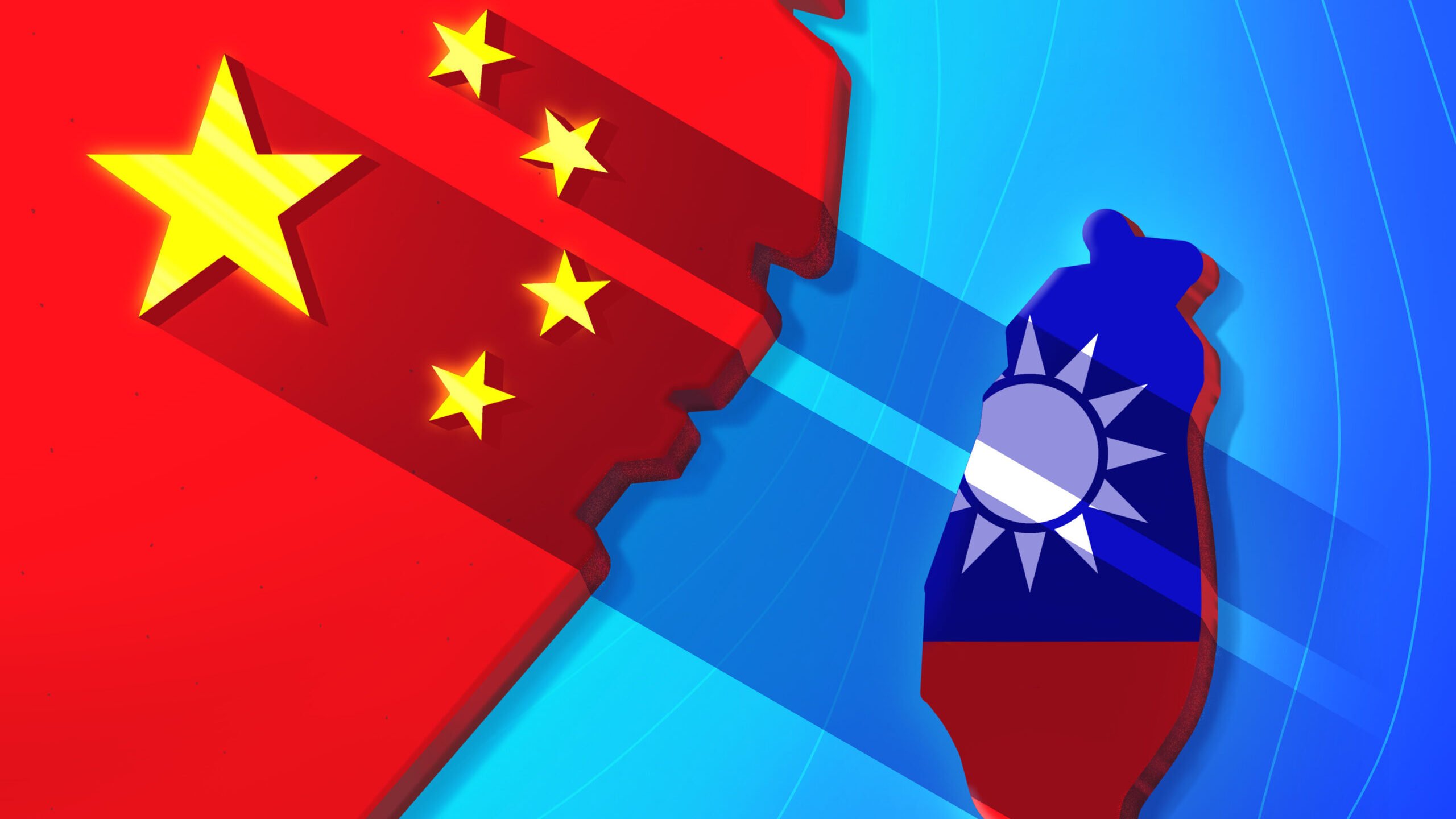
China and Taiwan relationship illustration. Shadow of China’s ambitions for Taiwan. (Getty images)
In the days following Speaker of the House Nancy Pelosi’s visit to Taiwan, the Chinese military put on a dramatic show of force in the form of aggressive military exercises surrounding the island. But how much of that reaction had been planned for months and was simply a fortuitous, if impressive, display of the PLA’s increasing combat capabilities and ability to project power? Dean Cheng, Chinese military expert at the American Heritage Foundation think tank and member of the Breaking Defense Board of Contributors, peels back the onion, explaining what happened and how it illustrates how the Chinese military has changed.
China got tremendous propaganda value out of the PLA’s exercises and drills held after Nancy Pelosi’s Taiwan visit, but it is important to recognize that they were not conducted as a response to the Pelosi visit. Some elements (especially the missile overflights of Taiwan) were probably added due to the Pelosi visit, but the larger effort of training PLA forces would have happened, Pelosi or no.
They were part of the PLA’s summer exercise “season”; the Chinese military has typically held its largest exercises, such as the Dongshan amphibious drills, during the summer months. Exercises of this scale and extent, with hundreds of aircraft and dozens of ships, as well as many missile launches, require extensive planning and are not simply thrown together.

Dean Cheng
The PLA exercises were some of the largest ever conducted in the Taiwan Straits area. They reflect, in part, the effort by the PLA to improve its training regimen. This has been a high priority for the PLA, as indicated by the creation of a General Department for training within the Central Military Commission at the end of 2015, part of the most extensive package of reforms ever undertaken by the PLA. Improving the realism of PLA training has been a major focus of the last seven years. The operations held after Pelosi’s visit reflect that ongoing improvement effort. The exercises included, for example, operations in a “complex electromagnetic environment,” reflecting the reality that future wars will incorporate extensive electronic warfare, network and cyber warfare, and general disruption of C4ISR networks.
The exercises were almost certainly planned and executed by the Eastern War Zone command, in what are likely to have been some of the most extensive planning efforts since the establishment of the war zones at the end of 2015. The new war zone (zhanqu; 战区) — or theater — commands were another part of the massive overhaul of the PLA, and constitute the establishment of a standing wartime command structure in peacetime. By contrast, the earlier military regions were only peacetime organizations, to be replaced in wartime by organizations which might merge or divide those regions. Consequently, a constant theme in pre-2015 PLA exercises was trans-regional activities that would allow forces from one military region to operate in another.
Notably, PLA writings indicate that support for these exercises was also provided by other war zones, so that the exercises also incorporated trans-war zone activities. This likely built upon lessons learned from those pre-2015 trans-regional exercises.
It’s important to note, that these exercises involved joint operations among all the PLA’s services, including units of the PLA Navy, PLA Air Force, PLA Rocket Force and the PLA Strategic Support Force. They also included PLA Ground Force special operations forces and joint logistics operations. Part of the point of establishing the war zones was to permanently establish a joint headquarters structure, capable of planning, coordinating and integrating forces across all the likely domains of warfare: land, sea, air, outer space, and the electromagnetic spectrum and information space. As the Chinese analyze these exercises, it will be interesting to see what kinds of space information support operations the PLASSF undertook, as well as offensive and defensive space operations, and network warfare operations.
Some PLA writings note the range of operations undertaken. These include joint anti-submarine warfare, joint logistics, multi-carrier operations, and aerial refueling. While all of these have certainly been exercised over the past two decades, this has been one of the few times when all of them were incorporated into a single operation.
It is also likely that these exercises were an opportunity for the PLA to employ intelligence-ized (zhineng hua; 智能化) weapons and systems. “Intelligence-ized” systems are the third component of the ongoing PLA modernization effort. By 2027, the PLA is expected to be fully mechanized, fully informationized, and fully intelligence-ized. This last aspect involves the greater incorporation of artificial intelligence decision-making tools, onboard information processing, and other advanced information and computing technologies into weapons, C2 networks, and command decision-making processes. PLA actions in this series of exercises likely allowed them to test their current intelligence-ized capabilities.
While these exercises were primarily intended to allow the PLA to test their current weapons, command and control capacities, and sensors, they were also intended to provide political signals. One, of course, was China’s displeasure with the visit of the US Speaker of the House. But Chinese writings suggest a number of other intended messages.
Rejecting the mid-line (or median) of the Taiwan Strait
From Beijing’s perspective, the Taiwan straits are internal Chinese waterways, more comparable to Chesapeake Bay or Long Island Sound than the Gulf of Mexico or the Straits of Malacca. This not only applies to international shipping (especially warships), but also to its relations with Taiwan. These exercises, which included air and naval crossing of the mid-line of the straits, may well mark a regular Chinese effort to degrade the significance of the straits and force Taiwan, at least, to accept that there will be Chinese aircraft and ships regularly crossing the line. This, of course, will reduce Taiwan’s reaction time and increase potential tensions.
Signaling the decline of American power
In their previous large-scale exercise in the Taiwan straits in 1995-1996, the United States deployed two carrier battlegroups in response. The Chinese undoubtedly noted that this exercise, which included missile overflights of the island, led to a far more muted reaction. It is likely that they see this as a sign of the relative decline of American power. Indeed, the development of China’s anti-ship ballistic missile capability has often been attributed to their inability to respond in that crisis. One Chinese assessment noted that the exercises would deter foreign interference.
Signaling Chinese dominance of South China Sea
While the exercises took place around Taiwan, the same Chinese assessment noted that the missiles that targeted the southern region signaled that the PLA could strike the Bashi Channel, between Taiwan and the Philippines. Since this is one of the main entrances to the South China Sea, the article declares, the PLA can now effectively close that line of approach to the South China Sea. While this is a rather grandiose declaration, particularly against the US Navy, it is likely to be a source of concern for smaller states on the periphery of the South China Sea. None of the other claimants to the Spratlys, for example (Brunei, Malaysia, the Philippines, Vietnam) have substantial naval capabilities, and none field naval ballistic missile defense systems.
What is most worrisome are the possible lessons and behaviors that Beijing has learned that it may exploit in the future. Two are potentially destabilizing.
First, has China concluded that it can overfly Taiwan with impunity? Chinese ballistic missiles were deliberately targeted on an area east of the island. So they overflew the island to hit in the designated area. Taiwan tracked those missiles but did not try to intercept them, which undoubtedly would have generated a significant escalation in tensions. Might Beijing follow up in the future with additional tests that overfly the island? Just as important, would it be willing to risk overflights with unmanned aerial vehicles (UAVs)? Reports that Chinese UAVs entered restricted airspace over Kinmen (Quemoy) suggest that this may be a new method of testing Taiwan-controlled airspace. An escalatory step would be to fly over the main island, potentially daring Taipei authorities to engage or shoot down the UAV.
Second, is China likely to use future exercises to start to enforce their East China Sea air defense identification zone (ADIZ)? In November 2013, the Chinese declared an ADIZ that overlapped South Korean and Japanese ADIZs, and included airspace above the disputed Ieodo/Socotra Rock and Senkaku islands (claimed by the ROK and Japan respectively). Chinese closure zones for this exercise are in the southern portion of this ADIZ, and Chinese missiles impacted in waters that are part of Japan’s Exclusive Economic Zone. Given Chinese salami-slicing tactics in the South China Sea, does this mark a new effort at expanding Chinese claims in the East China Sea?
None of this is to suggest that conflict is imminent, but what does appear clear is that Beijing is striving to coerce its neighbors, not least Taiwan, through the display of its real and growing military capabilities. The exercises certainly highlight China’s strides in modernizing the PLA. At the same time, they also indicate the shift in relative strength from American superiority to equality — if not inferiority.
The next round of Chinese military activities, perhaps in response to the subsequent spate of foreign visits to Taiwan and growing European disenchantment with China, will probably help us better understand China’s capabilities and political stance.






















